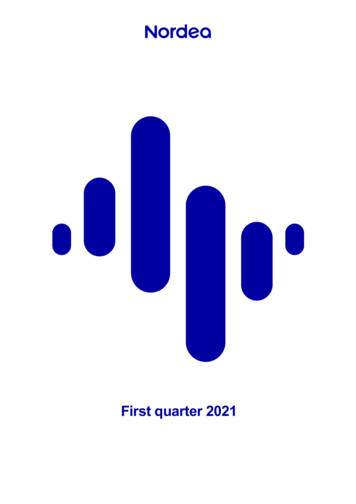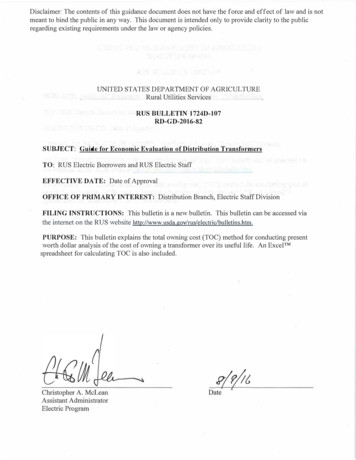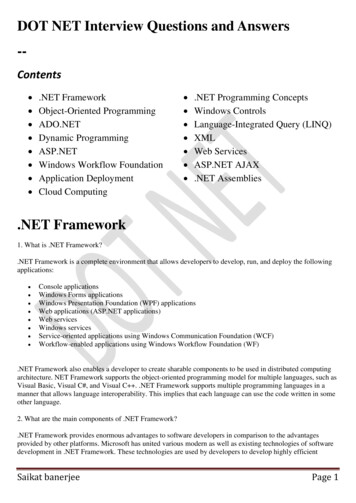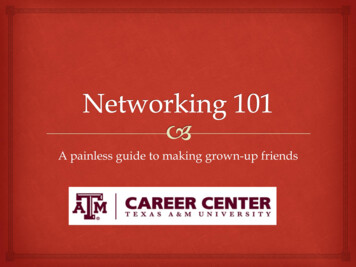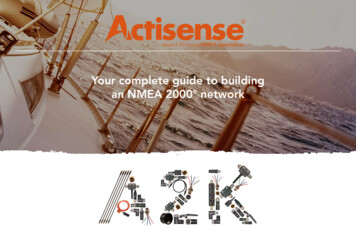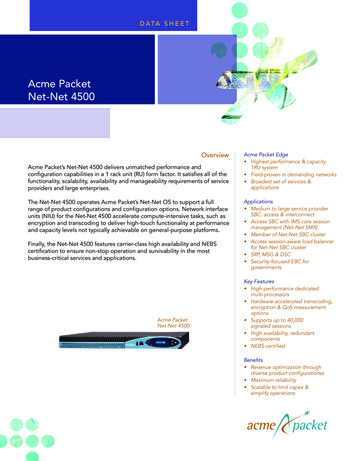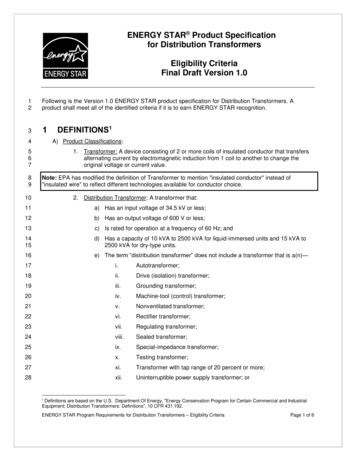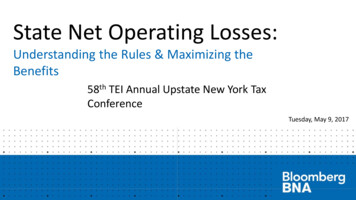
Transcription
State Net Operating Losses:Understanding the Rules & Maximizing theBenefits58th TEI Annual Upstate New York TaxConferenceTuesday, May 9, 2017
Agenda Key challenges in the State NOL areaUnderstanding the mechanics of State NOLsStrategies to monetize NOLsImpacts of Federal Tax Reform PlansQ&A58th TEI Annual Upstate New York Tax Conference2
58th TEI Annual Upstate New York Tax Conference3
Key challenges for state NOLsStates don’t follow federal NOL rulesStates differ on how to compute and use NOLsState NOL rules change from year to yearReporting on a group basis frequently means tracking NOLs byentity Some states allow sharing of losses and some do not Most states require modifications, limitations, suspensions, orother adjustments to NOLs Proper management of the NOL asset mitigates cash tax impactsand increases earnings per share 58th TEI Annual Upstate New York Tax Conference4
Current approach to managing NOLs Most create their own spreadsheets Time invested to research and keep up with the changing NOL rules Resources needed with Excel skills to program complex, related computations acrossentities and states Risks of broken links Lack of audit trail & permissions control Increasingly coming under scrutiny of internal and external auditors Understood by one or only a few people (what if creator leaves or retires?) Most then retype those numbers into: Compliance & Provision systems Other Excel workbooks to support provision, cash tax planning, etc.58th TEI Annual Upstate New York Tax Conference5
Questions You Should be Asking How do we maximize the tax / cash value of state NOLs in the year theyare generated? How do we maximize NOL utilization in carryforward years and utilize alarge NOL before it expires? How do we increase the opportunity to share NOLs between membersof a combined return? How do we maximize the use of pre-merger NOLs? How do we plan?58th TEI Annual Upstate New York Tax Conference6
Leveraging State NOLs Understand mechanics of NOL computation in year of generation & utilization Know the apportionment facts for each entity & any existing strategies in placeacross the states Have an inventory of the NOL generation & utilization Acquired – 382/SRLY Home grown Know Federal NOL situation & how translates to each state What is your motivation? Manage ETR? Tax Cash Benefit? Both?58th TEI Annual Upstate New York Tax Conference7
Mechanics of State NOL
Basic Concepts Federal Taxable Income (Loss) – Form 1120 Lines 28, 29a, 29b State’s treatment of Federal NOL Pre-apportionment NOL Post-apportionment NOL Apportionment factor in year of generation vs utilization Net Add modifications (NAMs) State’s rules on grouping To compute state taxable income vs NOL Share vs no share Entity changes – M&A – 382/SRLY State’s NOL rules – c/o, c/b, limitations, suspensions, etc.58th TEI Annual Upstate New York Tax Conference9
State Treatment of Federal NOL 16 states add-back Federal NOL 25 states start with Line 28 FTI before NOL Some states modify Federal NOL Delaware uses federal NOL deduction (with limitation) Maryland uses federal NOL with potential modification May require NOL recapture of excess of additions over subtractions from year NOL incurredwhen NOL is claimedMissouri Limits NOL carryback to 30,000; balance may be carried-forwardMay require modification to NOL through state additions or subtractionsVermont (prior to 2007)Virginia (requires adjustments) Requires adjustments for state additions and subtractions from year NOL incurred58th TEI Annual Upstate New York Tax Conference10
Carryback & Carryover Rules Carryback 29 States do not allow NOL carrybacks 3 States allow NOLs to be carried back 3 years 13 States allow NOL carrybacks to same extent as federal law or allow NOLs to becarried back 2 years Carryforward Approximately 26 States allow NOLs to be carried forward 15 or 20 years 3 States allow NOLs to be carried forward 5 or 7 years 5 States allow NOLs to be carried forward 10 or 12 years 11 States allow NOLs to be carried forward to same extent as federal lawAbove is generalized over the past 2 decades58th TEI Annual Upstate New York Tax Conference11
Post-Apportionment Rules Majority of states (36 plus DC) Calculate state NOL based on apportionment percentage inyear NOL incurred Includes: Massachusetts (2009 ; combined groups);(2010 ; separate return filers and S corporations) New York (2015 ) Vermont (2007 )58th TEI Annual Upstate New York Tax Conference12
Pre-Apportionment RulesLess than a dozen (11) states calculate state NOL based on apportionmentpercentage in year NOL used – includes: DelawareKentuckyMarylandMassachusetts (before 2009 combined groups; before 2010 separate return filers and Scorporations)MissouriNew JerseyNew MexicoNew York (before 2015)Rhode IslandVermont (before 2007)Virginia58th TEI Annual Upstate New York Tax Conference13
Group Reporting Combined or Consolidated Reporting 28 states plus the District of Columbia allow or require combined reporting 24 states that have default filing method of separate reporting or combined alsoallow elective consolidation (note: Kentucky requires mandatory nexus consolidation) Combining Group Income The majority of combined reporting states combine group members income on agroup apportionment basis Mississippi and Virginia combined return (consolidated return in other states)combines group members income on a ‘stacked’ entity-by-entity apportionmentbasis58th TEI Annual Upstate New York Tax Conference14
Group Reporting Complicates NOLs Group-Post: Most states combine incomes on a group basis and thencalculate and track NOLs on a post-apportionment basis Group-Pre: group basis for income, but NOLs on pre-apportionmentKentucky, Missouri, New Mexico, Rhode Island, and Virginia consolidatedreturn (combined returns in other states) Stacked-Entity-Post: Mississippi Stacked-Entity-Pre: Virginia combined return (consolidated return in otherstates) Intrastate: California uses group based apportionment to compute thegenerated income/loss, but in NOL area, when it’s time to utilize an NOL, eachentity must track it’s own NOL – there is no sharing of losses58th TEI Annual Upstate New York Tax Conference15
Sharing vs No Sharing Current Year Losses States generally allow current year losses to be shared among group memberswithout limitation Exception: Kentucky (consolidated return) limits NOLs to 50% of income realizedby remaining affiliated members that did not realize NOLs Carrybacks and Carryforwards Combined returns 15 states allow sharing among group members that were part of the originalloss year return 11 states plus District of Columbia do not allow sharing; only allow NOL c/bor c/f to be claimed by member that incurred the NOL Consolidated returns - majority of states have SRLY rules58th TEI Annual Upstate New York Tax Conference16
Limitations on Sharing Examples: Wisconsin – limits sharing of pre-2009 NOL carryforwards related to separatereporting (combined reporting started in 2009) Tax years before 2012: no sharing of pre-2009 NOL carryforwards with group Tax years after 2011: apply NOL carryforward to member’s own income, thenapply 5% of NOL c/f to other members Rhode Island – proposed regulations do not allow pre-2015 NOL carryforwards to beshared among members of a combined return (combined reporting started in 2015)58th TEI Annual Upstate New York Tax Conference17
Limitations on NOLsLimitations, Suspensions, NAMsExamples California - Phased in 2-year carryback period Limited NOL carrybacks for NOLs incurred in: Tax years beginning on or after January 1, 2013 and before January 1, 2014 to 50% ofNOL incurred Tax years beginning on or after January 1, 2014 to 75% of NOL incurredIllinois - Limited NOL carryover deduction to 100,000 per tax year for tax years ending afterDecember 31, 2012 and prior to December 31, 2014Delaware (permanent limitation) Does not have a state NOL / Utilizes federal NOL deduction Limits NOL carrybacks to only 30,000; remaining balance of NOL is carried forward58th TEI Annual Upstate New York Tax Conference18
Group Reporting Examples
Group Return Post-Apportionment58th TEI Annual Upstate New York Tax Conference20
Group Return Pre-Apportionment58th TEI Annual Upstate New York Tax Conference21
Stacked Return Post-Apportionment58th TEI Annual Upstate New York Tax Conference22
Stacked Return Pre-Apportionment58th TEI Annual Upstate New York Tax Conference23
Sharing/No Sharing Examples
Group-Post & Allows ShareExample 158th TEI Annual Upstate New York Tax Conference25
Group NOL Tracking ScheduleExample 158th TEI Annual Upstate New York Tax Conference26
NOL UtilizationExample 158th TEI Annual Upstate New York Tax Conference27
NOL Remaining with ExpirationExample 158th TEI Annual Upstate New York Tax Conference28
Group-Post No SharingExample 258th TEI Annual Upstate New York Tax Conference29
Group NOL Tracking ScheduleExample 258th TEI Annual Upstate New York Tax Conference30
NOL UtilizationExample 258th TEI Annual Upstate New York Tax Conference31
NOL Remaining with ExpirationExample 258th TEI Annual Upstate New York Tax Conference32
58th TEI Annual Upstate New York Tax Conference33
Apportionment Strategy
Maximizing NOLs via Apportionment In year NOL generated Post-Apportionment states Make NOL larger through inter-company transactions, other state taxdeductions, or state allocable income Increase apportionment % in year incurred Pre-Apportionment states - focus on utilization year In NOL utilization years Increase apportionment % in year used Increase tax base through inter-company transactions Transfer / sell assets to entity with NOL that create income Convert C corporation to single-member LLC to apply losses against income of otherentity58th TEI Annual Upstate New York Tax Conference35
Mixed Industry Groups58th TEI Annual Upstate New York Tax Conference36
Post Apportionment Separate TN Filing separately in TN Wayne has large loss and a 5%TN apportionment Stark has large income and a 95%TN apportionmentTotal Tax Liability: 7,129,45758th TEI Annual Upstate New York Tax Conference37
Post Apportionment – DisregardedNow files 1 TN ReturnTotal Tax Liability: 4,201,926Tax Savings: 2,927,531Stark gets benefit of: Current Wayne loss Wayne NOL carryovers Apportionment reduced from 95% to 65%58th TEI Annual Upstate New York Tax Conference38
TN Combined NOL ScheduleWayne and Stark combined TN NOL tracker shows NOL generation and utilization.58th TEI Annual Upstate New York Tax Conference39
Group Reporting Strategy
Sharing NOL carryover problem PROBLEM: How do we increase the opportunity to share NOLcarryovers between members of a combined return? SOLUTIONS: During year of loss - If you know an entity will have losses and isnot filing combined, consider the potential for filing combined inthe year loss is generated (since current losses are generallysharable) May be able to use argument similar to New Mexico case If not, consider converting C corp to SMLLC58th TEI Annual Upstate New York Tax Conference41
New Mexico Covenant Case In the Matter of the Protest of Covenant Transportation Group Inc., N.M.Tax’n & Rev. Dep’t, No. 14-45 (Dec. 29, 2014) Parent and 3 subsidiaries 2 subsidiaries had NOLs All 3 subsidiaries filed separate New Mexico returns Federal law (IRC 172(a)) allows consolidated groups to deductmember NOLs arising in separate years NM regulation incorporates federal law and allows NOLdeductions after change of reporting method Hearing officer held that nothing in NM law alters federal rules Covenant could file combined return and utilize sub NOLs againstincome of other members of combined return58th TEI Annual Upstate New York Tax Conference42
NM Separate Reporting Example Each files separately in NM Wayne large loss & 3% NMapportionment with NOL c/o Stark large income & 90% NMapportionment (no NOLs) Oscorp large loss & 15% NMapportionment with NOL c/o Total New Mexico tax liability: 6,436,18958th TEI Annual Upstate New York Tax Conference43
NM Combined Reporting Example Combined filing Total tax liability: 399,549 Tax savings: 6,036,64058th TEI Annual Upstate New York Tax Conference44
Different Carryback/over Periods
Carryback/Carryforward Periods Since most states disallow carrybacks or have short carryback periods,utilization in the future is vital 29 states do not allow NOL carrybacks Use some of the techniques we have described to improve utilization,such as: Apportionment factor adjustments State additions and subtractions Intercompany transactions Entity conversions58th TEI Annual Upstate New York Tax Conference46
Special States
PA NOL cap controversy Nextel Commc'ns of the Mid-Atlantic, Inc. v. Pennsylvania, No. 98 F.R.2012, 2015 BL 384486 (Pa. Commw. Ct. Nov. 23, 2015) – currentlypending before PA Supreme Court Is PA NOL cap unconstitutional? Current cap is larger of 5 million or 30% of taxable income During the year in the case (2007), the cap was 3 million or12.5% of taxable income Court unanimously ruled Nov. 2015 cap as unconstitutional PA appealed Oral arguments heard in PA Supreme Court 4/5/1758th TEI Annual Upstate New York Tax Conference48
PA NOL cap controversy Potential remedies Remove limitation entirely Remove flat dollar cap and keep % cap Remove 20 year carryover limit If flat dollar cap is removed and % cap kept, Nextel will receive no refund Nextel could win case and get nothing Others could benefit from Nextel case In 2007: 19,537 companies in PA had NOL carryovers; 19,303 had income ofless than 3 million and were able to reduce their taxable income to zero Only 1.2% or just 234 companies had income of more than 3 million Nextel had income of 45 million with NOL carryovers of 150 million; NOLdeduction was limited to 5.6 million58th TEI Annual Upstate New York Tax Conference49
Montana NOL disallowance Montana disallows NOL deduction for any pre-merger Montana NOLs of merged corporations (MT.Code Ann. Sec. 15-31-119(8) GBN, Inc. vs Montana (1991) Surviving corporation could not deduct NOLs of each merged corporation sustained prior tomerger Pre-merger loses by surviving and target corporations both disallowed A simple (F reorganization) is tax free for federal tax purposes and tax attributes carryover Tax attributes of Montana NOLs don’t carryover according to Montana MT. Admin. Reg. 42.23.804(3) disallows pre-conversion NOLs of a corporation that has converted toa disregarded entity58th TEI Annual Upstate New York Tax Conference50
MT Cautionary Tale If an empty shell corporation (NewCo)is created in a new state and CurrentCois merged into NewCo, Montana NOLcarryovers will not transfer to NewCo58th TEI Annual Upstate New York Tax ConferenceIf 2 corporations merge, the pre-mergerNOLs of both the surviving and target arenot allowed to be carried to the survivingentity51
Louisiana NOL Complexity Abounds For tax returns filed on or after 7/1/15, the LA NOL deduction is limited asfollows: First, by 72% of the LA NOL carryforward Then, by 72% of LA net income Simple example: 2018 NOL carryforward 1 million 72% 720,000 LA net income in 2019 3 million 72% 2,160,000 2019 NOL utilization is limited to 720,00058th TEI Annual Upstate New York Tax Conference52
Louisiana NOL complexity The order of LA NOL carryover utilization Tax years before January 1, 2017 use FIFO method Tax years after January 1, 2017 use LIFO method Example: LA NOL carryover schedule is as follows: 2014 – (500,000) 2015 – (700,000) 2016 – (900,000) If the 2017 tax return shows LA net income of 400,000, the 2016 NOLwould be used first Under the LIFO method, prior year NOLs have a higher probability of expiringbefore being utilized58th TEI Annual Upstate New York Tax Conference53
Louisiana NOL complexity For tax years filed on or after 7/1/2015 LA NOL carryback period changed from 3 years to zero LA NOL carryforward period changed from 15 to 20 years Disallowing carryback eliminates the opportunity to obtain immediate benefitsfrom Louisiana NOLs Louisiana may have extended the carryforward period, but the other rules wediscussed make it more difficult to utilize NOLs before they expire58th TEI Annual Upstate New York Tax Conference54
58th TEI Annual Upstate New York Tax Conference55
Acquisitions/Reorg Challenges
Proactive State Tax Planning is KeyPrior to the implementation of any acquisition/reorganization Determine whether state NOL carryovers can be usedsubsequent to that acquisition/reorganization Know 382/SRLY impacts ASC 805 & ASC 740 requires M&A impact during a quarter beincluded in quarterly financial statements Model out impacts to group filings & know carryover values Adjust Valuation Allowance accordingly58th TEI Annual Upstate New York Tax Conference57
State IRC Sec.382 Limitations Internal Revenue Code (IRC) Sec. 382 limits the use of NOLcarryforwards and certain built-in losses following an ownershipchange The ‘good’ news: 35 states conform to IRC Sec. 382 The ‘bad’ news: Most states do not provide ‘explicit’ guidance on how toapply IRC Sec. 38258th TEI Annual Upstate New York Tax Conference58
State IRC Sec. 382 Limitations Main questions: Is the federal IRC Sec. 382 limitation apportioned? 7 states explicitly say ‘yes’ 24 states provide no guidance If yes, what apportionment % is used? In year of ownership change orwhen utilized? 26 states provide no guidance Is the IRC Sec. 382 limitation calculated on an entity or group basis withina state combined return? 27 states provide no guidance58th TEI Annual Upstate New York Tax Conference59
State IRC Sec. 382 Limitations - Louisiana Corporations that acquire a loss corporation are generally required to limit the allowedLouisiana NOL carryover from an acquired corporation using one of the following threemethods - the NOL that the acquiring corporation is allowed to deduct each year is limited to:1. (value of the loss corporation x LA apportionment ratio) x long-term tax-exempt rate;OR2.the value of the loss corporation x (LA income / federal income from all sources on aLA basis) x long-term tax-exempt rate, OR3.LA NOL available from the acquired corporation for the year x (NOL from the acquiredcorporation allowed for federal purposes / federal NOL available from the acquiredcorporation for the year)Louisiana Admin. Rev. Ruling No. 06-008 (May 31, 2006)58th TEI Annual Upstate New York Tax Conference60
State IRC Sec. 382 Limitations – South Carolina South Carolina follows IRC Sec. 382 SC IRC Sec. 382 limitation depends on whether the loss corporation is 100% based in SouthCarolina or operates in multiple states, during the taxable year that the ownership changeoccurs If 100% based in South Carolina during the taxable year that the ownership change occurs, SC IRC Sec. 382 limitation federal IRC. Sec. 382 limitation If operating in multiple states during the taxable year that the ownership change occurs SC IRC Sec. 382 limitation the federal IRC Sec. 382 limitation x SC apportionmentfactor for the taxable year that the ownership change occurs58th TEI Annual Upstate New York Tax Conference61
State IRC Sec. 382 Limitations – South Carolina For example, assume the following for Company A at the time of ownership change: Company A’s value is 5,000,000; The applicable federal long-term tax exempt rate is 2.80%; Company A’s federal NOL carryforward is 1,000,000; Company A’s previously apportioned South Carolina NOL carryforward is 350,000; Company A’s South Carolina apportionment ratio for the year of the ownershipchange is 25% The South Carolina IRC Sec. 382 limitation is 35,000 ( 5,000,000 x 2.8% x 25%). The taxpayer can use its pre-ownership change South Carolina NOL carryforward to offset upto 35,000 of its South Carolina taxable income in each year following the ownership change58th TEI Annual Upstate New York Tax Conference62
State IRC Sec. 382 Limitations – South Carolina Any pre-ownership change SC NOL carryforward that cannot be deducted in the tax yearbecause of the SC IRC Sec. 382 limitation is carried forward to the following year SC NOL remains subject to the maximum 20 year carryforward period58th TEI Annual Upstate New York Tax Conference63
State IRC Sec. 382 Limitations - EXAMPLE South Carolina example Track pre-change lossesseparately (before 2016)58th TEI Annual Upstate New York Tax Conference64
State IRC Sec. 382 Limitations - EXAMPLE South Carolina example Separate schedule for 382limited NOL58th TEI Annual Upstate New York Tax Conference65
State IRC Sec. 382 Limitations - EXAMPLE South Carolina example Adjustment for 382utilization on regular NOLschedule58th TEI Annual Upstate New York Tax Conference66
State Impacts of Federal Tax Reform
History Shows States Decouple58th TEI Annual Upstate New York Tax form-the-impact-on-states/69
Federal Tax Reform for NOLs Proposed Federal tax changes: Full expensing of Fixed Assets (if enacted) drives up NOLs! Offset by Border Tax or other non-allowable deductions orincreases to taxable income? NOL carryforward indefinitely - No carryback Unused NOL carryforward has interest factor adjustment tocompensate for inflation In year of utilization NOL C/F utilization limited to 90% of taxable income IRC 382 No mention yet 58th TEI Annual Upstate New York Tax Conference70
Federal Tax Reform Will states conform to NOL carryforward indefinitely? 26 states carryforward 15 to 20 years; some 5 to 12 years Other states follow federal currently Will states conform to no carryback? Currently 29 states have no carryback Will states conform to interest factor adjustment and to 90% offset limitation? In non-conforming pre-apportioned NOL states States would have different NOL carryforward schedules and no longer simply be usingthe federal NOL In post-apportioned NOL states Already tracking a different NOL amount58th TEI Annual Upstate New York Tax Conference71
Key Take Aways
Key Take Aways According to an analysis performed by Bloomberg BNA of the financial statements ofthe Fortune 1000, an estimated 200 billion in NOLs is sitting on their books. State NOL tracking is essential to tax compliance, provision and financial statementcompliance. Managing and maximizing the cash / tax benefits related to the generation andutilization of state NOLs is complex. Strategies are available, but must be modeled. Tax departments are currently focused on leveraging technology to move away fromspreadsheets to create tax ready data, better manage cash tax, reduce effective taxrate, and increase earnings per share. Technology exists to do the same for State NOLs.58th TEI Annual Upstate New York Tax Conference73
Q&A58th TEI Annual Upstate New York Tax Conference74
ThankYou!To learn more about managing state NOLs & state tax analysis in general,contact our speaker:Diane Tinney at 703.341.3635 or dtinney@bna.comDisclaimer: This presentation contains general information only and the speakers and their companies are not, by means of thispresentation, rendering accounting, business, financial, investment, legal, tax, or other professional advice or services. Thispresentation is not a substitute for such professional advice or services, nor should it be used as a basis for any decision or actionthat may affect your business. Before making any decision or taking any action that may affect your business, you should consult aqualified professional advisor. The speakers and their companies shall not be responsible for any loss sustained by any person whorelies on this presentation.
Wayne has large loss and a 5% TN apportionment Stark has large income and a 95% TN apportionment Total Tax Liability: 7,129,457. 58 th TEI Annual Upstate New York Tax Conference 38 Post Apportionment - Disregarded. Total Tax Liability: 4,201,926. Tax Savings: 2,927,531.
